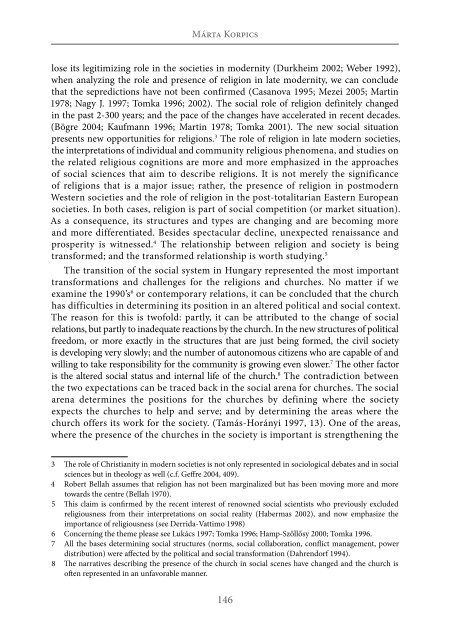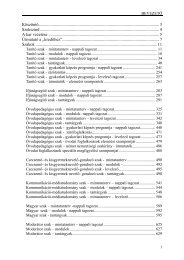ACTA SZEKSZARDIENSIUM - Pécsi Tudományegyetem Illyés Gyula ...
ACTA SZEKSZARDIENSIUM - Pécsi Tudományegyetem Illyés Gyula ...
ACTA SZEKSZARDIENSIUM - Pécsi Tudományegyetem Illyés Gyula ...
You also want an ePaper? Increase the reach of your titles
YUMPU automatically turns print PDFs into web optimized ePapers that Google loves.
Márta Korpics<br />
lose its legitimizing role in the societies in modernity (Durkheim 2002; Weber 1992),<br />
when analyzing the role and presence of religion in late modernity, we can conclude<br />
that the sepredictions have not been confirmed (Casanova 1995; Mezei 2005; Martin<br />
1978; Nagy J. 1997; Tomka 1996; 2002). The social role of religion definitely changed<br />
in the past 2-300 years; and the pace of the changes have accelerated in recent decades.<br />
(Bögre 2004; Kaufmann 1996; Martin 1978; Tomka 2001). The new social situation<br />
presents new opportunities for religions. 3 The role of religion in late modern societies,<br />
the interpretations of individual and community religious phenomena, and studies on<br />
the related religious cognitions are more and more emphasized in the approaches<br />
of social sciences that aim to describe religions. It is not merely the significance<br />
of religions that is a major issue; rather, the presence of religion in postmodern<br />
Western societies and the role of religion in the post-totalitarian Eastern European<br />
societies. In both cases, religion is part of social competition (or market situation).<br />
As a consequence, its structures and types are changing and are becoming more<br />
and more differentiated. Besides spectacular decline, unexpected renaissance and<br />
prosperity is witnessed. 4 The relationship between religion and society is being<br />
transformed; and the transformed relationship is worth studying. 5<br />
The transition of the social system in Hungary represented the most important<br />
transformations and challenges for the religions and churches. No matter if we<br />
examine the 1990’s6 or contemporary relations, it can be concluded that the church<br />
has difficulties in determining its position in an altered political and social context.<br />
The reason for this is twofold: partly, it can be attributed to the change of social<br />
relations, but partly to inadequate reactions by the church. In the new structures of political<br />
freedom, or more exactly in the structures that are just being formed, the civil society<br />
is developing very slowly; and the number of autonomous citizens who are capable of and<br />
willing to take responsibility for the community is growing even slower. 7 The other factor<br />
is the altered social status and internal life of the church. 8 The contradiction between<br />
the two expectations can be traced back in the social arena for churches. The social<br />
arena determines the positions for the churches by defining where the society<br />
expects the churches to help and serve; and by determining the areas where the<br />
church offers its work for the society. (Tamás-Horányi 1997, 13). One of the areas,<br />
where the presence of the churches in the society is important is strengthening the<br />
3 The role of Christianity in modern societies is not only represented in sociological debates and in social<br />
sciences but in theology as well (c.f. Geffre 2004, 409).<br />
4 Robert Bellah assumes that religion has not been marginalized but has been moving more and more<br />
towards the centre (Bellah 1970).<br />
5 This claim is confirmed by the recent interest of renowned social scientists who previously excluded<br />
religiousness from their interpretations on social reality (Habermas 2002), and now emphasize the<br />
importance of religiousness (see Derrida-Vattimo 1998)<br />
6 Concerning the theme please see Lukács 1997; Tomka 1996; Hamp-Szőllősy 2000; Tomka 1996.<br />
7 All the bases determining social structures (norms, social collaboration, conflict management, power<br />
distribution) were affected by the political and social transformation (Dahrendorf 1994).<br />
8 The narratives describing the presence of the church in social scenes have changed and the church is<br />
often represented in an unfavorable manner.<br />
146




